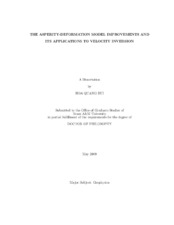| dc.description.abstract | Quantifying the influence of pressure on the effective elastic rock properties
is important for applications in rock physics and reservoir characterization. Here I
investigate the relationship between effective pressure and seismic velocities by performing
inversion on the laboratory-measured data from a suite of clastic, carbonate
and igneous rocks, using different analytic and discrete inversion schemes. I explore
the utility of a physical model that models a natural fracture as supported by asperities
of varying heights, when an effective pressure deforms the tallest asperities,
bringing the shorter ones into contact while increasing the overall fracture stiffness.
Thus, the model is known as the ?asperity-deformation? (ADM) or ?bed-of-nails?
(BNM) model. Existing analytic solutions include one that assumes the host rock is
infinitely more rigid than the fractures, and one that takes the host-rock compliance
into account. Inversion results indicate that although both solutions can fit the data
to within first-order approximation, some systematic misfits exist as a result of using
the rigid-host solution, whereas compliant-host inversion returns smaller and random
misfits, yet out-of-range parameter estimates. These problems indicate the effects of
nonlinear elastic deformation whose degree varies from rock to rock. Consequently,
I extend the model to allow for the pressure dependence of the host rock, thereby
physically interpreting the nonlinear behaviors of deformation. Furthermore, I apply
a discrete grid-search inversion scheme that generalizes the distribution of asperity
heights, thus accurately reproduces velocity profiles, significantly improves the fit and helps to visualize the distribution of asperities. I compare the analytic and numerical
asperity-deformation models with the existing physical model of elliptical ?pennyshape?
cracks with a pore-aspect-ratio (PAR) spectrum in terms of physical meaning
and data-fitting ability. The comparison results provide a link and demonstrate the
consistency between the use of the two physical models, making a better understanding
of the microstructure as well as the contact mechanism and physical behaviors of
rocks under pressure. ADM-based solutions, therefore, have the potential to facilitate
modeling and interpretation of applications such as time-lapse seismic investigations
of fractured reservoirs. | en |


